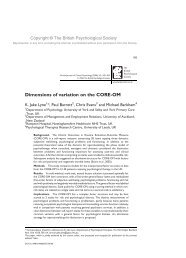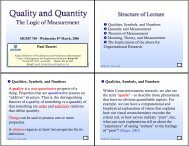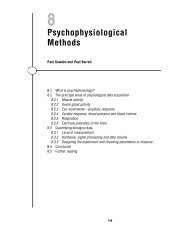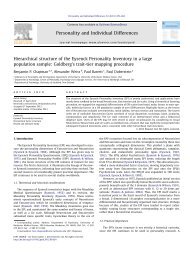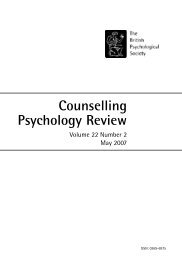95 - Paul Barrett
95 - Paul Barrett
95 - Paul Barrett
Create successful ePaper yourself
Turn your PDF publications into a flip-book with our unique Google optimized e-Paper software.
82 COMMENTARIESDownloaded By: [<strong>Barrett</strong>, <strong>Paul</strong>] At: 20:46 27 June 2008has been replicated in many countries since—no structural equation modeling,no data-model-driven regressions, no “made-up” latent variables, and, aboveall, no assumptions made as to the “quantitative” nature of the scale of riskpropensity. Clearly, the understanding behind why it works is limited, and thereis no obvious set of sufficiently detailed theoretical propositions that could betested to explain the many behavioral constituents of this risk scale; this willcome over time. But it works, to a quantified degree of predictive accuracy, andhas changed international forensic-legal practices.Given the work by Fan (1998) and the recent PhD thesis by Courville (2004),showing that IRT latent variable yields “scores” and parameter estimates whichare not appreciably different from simple sum-score test theory, clearly, thedebate over the superiority of modern “latent variable” psychometrics as partof an investigative science over “back of the matchbox” use of sum-scores ispointless. The fact of the matter is that both seem to work equally as well inproducing what are essentially the same scores, when properly representativesamples of questionnaire data are analyzed.The obvious conclusion is that if we are to generate progress in our science,increasingly sophisticated methods of statistical data-model analysis are notgoing to help. Something about the way we go about construing psychologicalvariables, their measurement, and their presumed causal relations is wrong.That’s where our efforts should be concentrated as scientists, not on yet morequestionnaire item test theory and assumption-laden structural latent variablemodels that ignore the fundamental issues of quantitative measurement. Wemight seriously consider whether psychology might be, for all intents andpurposes, a nonquantitative science best approached with variables that vary insimple orders and even just classes, and where equifinality (many causes of thesame observed outcome) is the order of the day (Richters, 1997).Adherence to modern psychometric dogma, inasmuch as I agree with Michellthat it is a pathology of science, is strangling innovation and creativity in areasconcerning the investigation of psychological phenomena. In 1997, Blinkhornconcluded his own review of 50 years’ of test theory with the following:A more radical view is that current styles of test theory simply have no more ofpractical value to offer, that the implicit assumptions which have guided researchfor nearly a hundred years place constraints on what can be achieved which haveno more elasticity, and that a new start is needed. It is not a story of failure but ofpragmatic success that has reached its limits, and indeed reached them some timeago.The challenge is to recover the element of surprise—astonishment even—which greeted the developments of the first decade of this century when effectivepsychological measurement was first demonstrated. For too long test theory hasconcerned itself with ever cleverer accounts of unimproved practical effectivenessand not with recommendations as to how to devise more effective tests. (p. 183)



